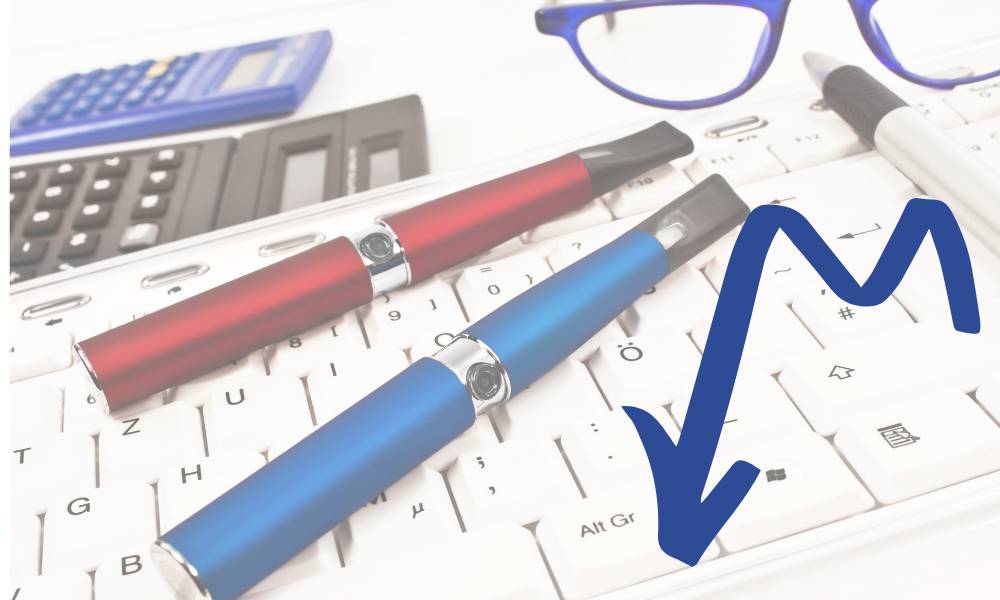
The U.S. Centers for Disease Control and Prevention (CDC), in collaboration with various partners, released two papers recently in Morbidity & Mortality Weekly Report (MMWR) highlighting recent changes in U.S. e-cigarette use and sales.
About 3.6 million U.S. youth reported current (in the past 30 days) e-cigarette use in 2020, reflecting a decline from 5.4 million in 2019, according to the National Youth Tobacco Survey (NYTS) conducted in partnership with the U.S. Food and Drug Administration (FDA). NYTS also found that the types of e-cigarette products youth are using has shifted Among youth e-cigarette users, pre-filled cartridges remained the most commonly used product type; however, disposable e-cigarette use has increased 1,000% among high school students and 400% among middle school students since 2019.
NYTS findings also showed that most (8 in 10) current youth e-cigarette users reported using flavored e-cigarettes. While the use of fruit and mint flavored e-cigarettes was common among users in 2020, the use of menthol flavored e-cigarettes was also prominent.
“Although the decline in e-cigarette use among our Nation’s youth is a notable public health achievement, our work is far from over,” said CDC Director Robert R. Redfield, MD. “Youth e-cigarette use remains an epidemic, and CDC is committed to supporting efforts to protect youth from this preventable health risk.”
These findings were consistent with a second report released today in MMWR, which assessed trends in U.S. e-cigarette sales. Pre-filled cartridges remain the leading type of e-cigarettes sold, but disposable product sales increased within the past year. Moreover, among pre-filled cartridge sales, menthol flavored products comprised more than three-fifths (61.8%) of all flavored products sold.
NYTS data show increase in disposable e-cigarette use
CDC and FDA analyzed data from the 2020 NYTS, a survey of U.S. middle (grades 6-8) and high (grades 9-12) school students conducted during January 16–March 16, 2020.
In 2020, 19.6% of high school students and 4.7% of middle school students currently used e-cigarettes, a decline from 27.5% and 10.5%, respectively, in 2019. Consistent with 2019 findings, pre-filled pods/cartridges were the most commonly used device type among youth e-cigarette users. However, from 2019 to 2020, disposable e-cigarette use increased from 2.4% to 26.5% (1,000%) among high school e-cigarette users and from 3.0% to 15.2% (400%) among middle school e-cigarette users.
Majority of youth e-cigarette users use flavored e-cigarettes
A majority of youth e-cigarette users reported using flavored e-cigarettes in 2020, including 82.9% of high school e-cigarette users and 73.9% of middle school e-cigarette users.
Among high school students who currently used any type of flavored e-cigarettes, the most common flavors were fruit (73.1%); mint (55.8%); menthol (37.0%); and candy, desserts, or other sweets (36.4%). Among middle school students, the most common flavors were fruit (75.6%); candy, desserts, or other sweets (47.2%); mint (46.5%); and menthol (23.5%).
Retail sales indicate rise in disposable products and menthol popularity
For the second study, CDC, in collaboration with the CDC Foundation and Truth Initiative, analyzed retail scanner data during September 14, 2014–May 17, 2020, to assess trends in U.S. e-cigarette sales.
The retail sales data are consistent with the NYTS data. While pre-filled cartridges remained the leading product type sold, disposable sales increased from 10.3% in August 2019 to 19.8% of total sales by May 2020. Among pre-filled cartridge sales, the proportion of mint sales declined beginning in August 2019, and by May 2020, menthol (61.8%) dominated the market.
What more can be done about youth tobacco use?
“These findings reinforce the importance of continuing to focus on the strategies that work to reduce youth tobacco product use while keeping pace with emerging trends in tobacco products,” said Karen Hacker, MD, MPH, Director of CDC’s National Center for Chronic Disease Prevention and Health Promotion. “Implementing these strategies at the national, state, and local levels is integral to preventing and reducing youth tobacco product use, including e-cigarettes.”
In addition to regulating the manufacturing, marketing, and sale of e-cigarettes by FDA, strategies to reduce e-cigarette use among youth include: increasing price, implementing comprehensive smoke-free policies that include e-cigarettes, restricting young peoples’ access to e-cigarettes, licensing retailers, developing educational initiatives targeting young people, curbing youth-appealing marketing, and implementing strategies to reduce youth access to flavored tobacco products.


Bulloch Public Safety
06/23/2025 Booking Report for Bulloch County

Bulloch Public Safety
06/30/2025 Booking Report for Bulloch County

Bulloch Public Safety
7/14/2025 Booking Report for Bulloch County

Bulloch Public Safety
7/11/2025 Booking Report for Bulloch County

Bulloch Public Safety
7/09/2025 Booking Report for Bulloch County









